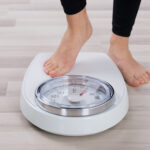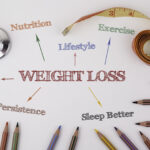
With obesity continuing to rise, a disturbing new trend is starting to pop up. No, it isn’t an increase in diabetes, heart problems, or joint issues — though those are directly linked to a higher weight.
According to a report published in the Journal of the American Medical Association, people are giving up on weight loss altogether, even though they’re aware that the extra weight they carry is quite dangerous.
One of the primary reasons people seem to ditch diets is because they feel that they’re just not realistic or are too difficult to maintain.
Make no mistake, the decision to ditch a diet can have serious consequences in the future. Instead of giving up, the solution is to set realistic weight loss goals that actually works.
Wondering how to get started? Here are six helpful tips to kick-start a healthier new life.
1. Stop Making Excuses
This tip isn’t intended to make anyone feel guilty or bad about themselves. But it’s important to be realistic, particularly when it comes to one’s health.
The fact of the matter is that many people don’t achieve their weight loss goals because they don’t even start.
Most of us are guilty of procrastination in one form or another, but when it comes to one’s health, the choices made today have a huge impact on one’s health tomorrow.
Start by taking at least one small, actionable step today. Even if it’s just calling a doctor or skipping that extra dinner roll tonight, these actions are the building blocks to a larger, successful weight loss plan.
2. Know The Difference Between Healthy And Unhealthy Weight Loss
It’s quite important to note that there are right and wrong ways to lose weight. Let’s take a quick second to look at both.
The wrong way is, unfortunately, by far the most common way. It consists of cutting calories to a dangerously low level, depriving the dieter of essential nutrients, or risking physical well-being for immediate results (which are often little more than water weight).
Most people have seen or even tried one of these approaches before. They often come in the form of a new diet trick that our favorite celebrity swears works wonders.
Yet these quick-fixes are more damaging than they appear. The Baby Food Diet, for instance, essentially starves participants.
Instead, the safest way to lose weight is to begin by consulting a medical professional. Typically, this will be a general practitioner who will run a few tests on a patient and come up with dietary goals based on safe, medically accurate metrics.
So while the Cookie Diet sounds great in theory, the fact of the matter is that it’s going to do one’s body far more harm than good. Be safe and talk to a doctor before beginning any major weight loss and exercise regimen.
3. Take A SMART Approach
Site regulars may be familiar with the SMART approach to weight loss already. But for those newcomers or those who want a quick refresher, here’s a breakdown of what SMART means.
SMART is an acronym that stands for Specific, Measurable, Attainable, Relevant, and Time. But what do these elements actually mean?
Specific
This step involves setting a clear goal. ‘To lose weight’ isn’t as helpful as ‘to lose five pounds’, for instance.
Measurable
Measurable actions feed directly into a dieter’s specific goal. These are often the numerical components of the goal.
Attainable
Keep it realistic in terms of the amount of weight lost and the timeframe in which it’s lost. A slow and steady approach often works best.
Relevant
Both why the weight should be lost and how will food and exercise will be tracked. Motivation is often a big factor, here.
Time
Set a reasonable, specific end goal. Using an event or milestone like a wedding or vacation is a common and effective end date.
4. Think Small, Dream Big
Piggybacking off of the previous section, it’s perfectly acceptable to set a lofty goal like losing 50 pounds. In some cases, it may be medically beneficial to do so, even.
However, the road to that massive goal is paved with small steps. Each decision made by a dieter has either a positive or negative effect.
Eating a bag of chips for dinner probably isn’t going to bring one closer to their goal. Eating a balanced meal with protein, fruits, and vegetables, on the other hand, fuels the body with helpful nutrients. Many of which may prevent cravings and stop overeating.
5. Realistic Weight Loss Goals Should Focus On A Long-Term Approach
Few who set out on a weight loss plan actually think about what happens after the diet. But once the number on the scale goes down, the real battle begins.
Don’t forget to factor long-term weight loss maintenance into the plan. Otherwise, it’ll be too easy to fall back into old bad habits and gain all that weight back.
6. Plan A Dietary Overhaul
Any great weight goal involves a considerable amount of exercise. But don’t forget that a healthy lifestyle starts with a better diet.
In fact, the vast majority of weight loss will occur from dietary changes. So it’s time to ditch the junk food and fill the fridge with healthier alternatives.
Don’t worry, that doesn’t mean giving up the foods you love. It just means exercising portion control and eating bad foods less often.
Use These Steps To Reach A Realistic Weight Goal
It can be difficult to achieve one’s weight loss goal, particularly if there’s a lot of weight to be lost. But keep at it and remember that setting realistic weight loss goals is the secret to beating the odds.
Don’t forget to be patient along the way. Weight loss takes a considerable amount of time and effort and it often takes a few weeks for a new weight loss plan to have an effect on one’s body.












